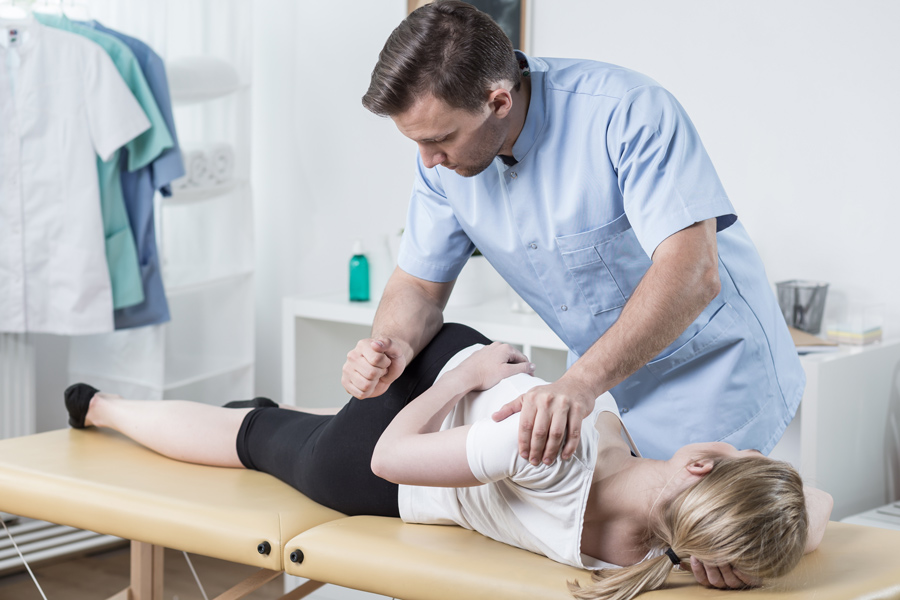Do joint manipulation sounds make a difference in physical therapy outcomes?
Joint manipulation, a manual technique used to decrease pain and improve joint mobility in physical therapy, is often accompanied by audible pops called joint manipulation sounds. Practitioners and patients tend to believe that feeling or hearing these pops means that their treatment was successful and that their symptoms will improve. Dr Rob Sillevis at Florida Gulf Coast University has evaluated the existing research evidence and also conducted his own research to determine if audible manipulation sounds are clinically relevant.
Joint manipulation is a manual technique often used by a variety of healthcare practitioners as a complementary treatment for a variety of musculoskeletal conditions, including joint dysfunction of the spine that contributes to back pain and stiffness. It involves applying a manipulation force to the spine to improve joint mobility and reduce pain. Thrust manipulation, more specifically, is the joint manipulation technique that involves the application of high-velocity and low-amplitude forces directed to joints.

During these treatments, there is often an audible popping sensation felt by the patient and the clinician, and sometimes this also comes with an audible popping sound. Although it is not entirely clear how this joint manipulation sound is produced, there is some evidence that it could be associated with the release of gas from the fluid inside the joint (synovial fluid) because of the rapid reduction in its pressure caused by the short-term extension of the joint capsule during the manoeuvre. Patients and some practitioners often regard this audible sound as a sign of a successful treatment, although there is no solid scientific evidence to support this. Dr Rob Sillevis at Florida Gulf Coast University conducted a comprehensive investigation to find out whether this audible pop has a clinical significance and an actual or perceived benefit on the body.
Searching the literature
The significance and benefit of one or more audible pops during spinal manipulation has been the subject of debate between practitioners and therefore, several previous studies have tried to evaluate it. Sillevis and his team have thoroughly searched the literature and found several studies that evaluated different aspects of how the audible pop might play a role in the positive effects of thrust manipulation of the spine, but all of them failed to show a direct benefit of a pop’s presence on the reported pain levels.

There was also no evidence of improvement in joint mobility or in the perceived level of disability. In addition, studies with a focus on the activity of the nervous system before and after the audible pop-producing thrust manipulation did not show any direct physiological changes. Based on this research, it seems clear that the audible pop should not be used by clinicians and researchers as a measure of success of spinal thrust manipulation. Unfortunately, both the research community and practitioners continue to ignore research evidence and still use the audible pop as a criterion for the success of the technique. Some clinicians also tend repeat manipulation forced on a joint until an audible pop is achieved.
The more, the better?
To further study if there is a clinical relevance of the audible popping sensation and sound, Sillevis and his team conducted an experiment involving 100 individuals with chronic neck pain, in this case defined as pain that was present for at least three continuous months. Half the participants received a session of thrust manipulation of the area of the upper back and, more specifically, the third and fourth thoracic vertebrae (bones that make the human spine), also called T3 and T4. The other half received a sham manipulation session (fake, also known as placebo effect joint manipulation). During the treatments, the practitioners recorded the number of popping sensations/audible pops. They also measured the diameter of the participants’ pupils before and after the manipulation (pupillometry) to assess the direct effect of the treatment on the autonomic nervous system. The idea behind this measurement was that differences in the diameter of the pupil had previously been shown to be an easy and reliable method of identifying immediate changes in the functioning of the autonomic nervous system.

By the end of the study, three participant groups were formed: the ones that experienced no pops, those who had one pop, and finally participants who experienced more than one pop. Of the 50 participants that had the thrust manipulation, an audible pop was detected in 32 of them, 18 of which experienced multiple audible pops.
Unfortunately, both the research community and practitioners continue to use the audible pop as a criterion for the success of the technique.After analysing the results, the researchers found that the thrust manipulation seemed to have resulted in a significant decrease of the joint pain compared to the sham manipulation; however, there was no significant difference found in pain reduction when comparing no-pop, one-pop, and multiple-pop groups. The analysis of the pupil measurements also did not reveal any significant differences in the range of pupil diameter before and after the manipulation between the three groups, showing that the presence of joint sounds does not affect the overall activity of the autonomic nervous system after a thrust manipulation.
Pops affecting brain activity?
To strengthen their case, Sillevis decided to investigate the direct effects of the joint manipulation audible sounds on brain wave activity. This experiment involved 57 healthy participants that received one session of high-velocity low amplitude thrust manipulation of their upper thoracic spine. An electroencephalogram (EEG), which is a recording of brainwave activity, was performed before and after the manipulation for each participant.
For the measurement, the team used 14 electrodes attached to different areas of the head. For 37 of the participants an audible pop was reported during the manipulation, while 20 had no pops.

Both pop and non-pop group EEG data showed similar changes in the brain activity under some of the electrodes, but neither group revealed changes in the temporal lobe activity, the area of the brain responsible for the perception of sound. Sillevis concluded that the audible pop caused by the thrust manipulation did not affect the activity in the auditory (sound) centres of the brain. The brainwave changes observed in both groups further support the fact that there is no clinical relevant benefit of audible manipulation sounds. Thrust manipulation with or without audible sound produces a similar immediate generalised relaxation effect in the brain.
Studying the lumbar area
The above findings intrigued Sillevis, leading him to study the effects of audible manipulation pops during a lumbar spine thrust manipulation on brain wave activity further.

This time, 44 healthy participants received a single session of the manipulation in their lumbar area, the lower part of their spine, while lying on their side. Brainwave activity using a portable EEG device was recorded before and immediately after the manipulation. This time, the researchers also performed two extra measurements: a third one a minute after the end of the session, and a fourth measurement four minutes after the manipulation was completed.
The audible pop adds no extra benefit to the treatment itself and has no value to determine manipulation success either.Twenty-three of the participants experience audible sounds, while the remaining 21 did not. Both groups had significant changes under the 14 electrodes applied to their heads before and after the treatment; however, there were no differences in the brain wave responses between the audible pop and non-audible pop groups.
These findings further support that there is no direct measurable effect on the brain wave activity from the audible pop. Furthermore, the change in brainwave activity did not support the notion of a placebo effect (perceived by the patient) and, therefore, the audible manipulation pop cannot be itself considered beneficial.
Stop using the pops!
The comprehensive research by Sillevis and his team further supports the understanding that the positive effects of thrust manipulation of the spine do not depend on the presence of an audible sound or sensation.

These findings lead to the conclusion that the audible pop adds no extra benefit to the treatment itself and has no value as a manipulation success indicator either. It is well known that patient expectations can dramatically affect their treatment outcomes, and to eliminate the negative bias and achieve the desired therapeutic results, both practitioners and patients need to stop focusing on producing joint manipulation sounds.
Personal Response
It is often very difficult to change a well-established but inaccurate idea in people’s minds. How do you suggest that health boards and research institutions can tackle this challenge for your research findings?Unfortunately, public perceptions reinforced by personal experiences create a misunderstanding regarding any actual true clinical cause-and-effect relationship. This perception has the tendency to result in a possible placebo/ nocebo effect. As we live in an era where we expect the application of evidence-based practiced medicine, it is imperative that we embrace all evidence and not just the evidence that might fit one’s idea or philosophy on a particular treatment approach. Since it has now been shown repeatedly that the audible manipulation sound has no clinical relevance, practitioners and teaching faculty should no longer reinforce this assumption in patients and students. This will lead to repeated manipulations targeting a particular joint, resulting in joint injury over time.